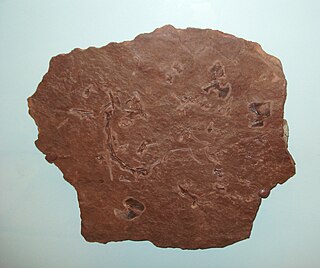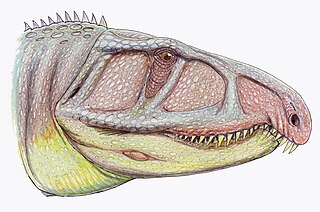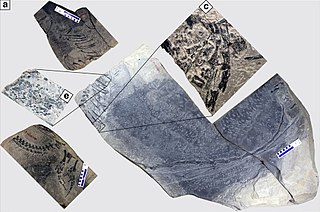Gwyneddosaurus is a possibly invalid genus of extinct aquatic tanystropheid reptile. The type species, G. erici was described in 1945 by Wilhelm Bock, who identified it as a coelurosaurian dinosaur related to Podokesaurus. Its remains were found in the Upper Triassic Lockatong Formation of Montgomery County, eastern Pennsylvania, and the holotype includes skull fragments, several vertebra, ribs, gastralia, partial shoulder and hip bones, and several forelimb and hindlimb elements found in soft shale, while the paratype includes a femur and a tibia. The type specimen is ANSP 15072 and it was discovered by Bock's four-year-old son while the paratype is only listed as ?(ASNP coll.). It was not a large animal; the type skeleton was estimated by Bock as 18 centimetres (7.1 in) long, and its thigh bone was only 23 millimeters long (0.91 in).

Macrocnemus is an extinct genus of archosauromorph reptile known from the Middle Triassic of Europe and China. Macrocnemus is a member of the Tanystropheidae family and includes three species. Macrocnemus bassanii, the first species to be named and described, is known from the Besano Formation and adjacent paleontological sites in the Italian and Swiss Alps. Macrocnemus fuyuanensis, on the other hand, is known from the Zhuganpo Formation in southern China. A third species, Macrocnemus obristi, is known from the Prosanto Formation of Switzerland and is characterized by gracile limbs. The name Macrocnemus is Greek for "long tibia".
Langobardisaurus is an extinct genus of tanystropheid archosauromorph reptile, with one valid species, L. pandolfii. Its fossils have been found in Italy and Austria, and it lived during the Late Triassic period, roughly 228 to 201 million years ago. Langobardisaurus was initially described in 1994, based on fossils from the Calcare di Zorzino Formation in Northern Italy. Fossils of the genus are also known from the Forni Dolostone of Northern Italy and the Seefeld Formation of Austria.

Sarmatosuchus is an extinct genus of archosauriform reptile found in sediments of Middle Triassic age and known from the single species Sarmatosuchus otschevi. It is one of the earliest stem-archosaur species known. The holotype and only specimen was found in lithified river deposits of the Donguz Formation exposed near the Berdyanka River, Orenburg region, Russia. The genus was originally included in the extinct family Proterosuchidae. However, later analysis by David Gower and Andrei Sennikov, the describing author, has removed it from the Proterosuchidae and designated it a basal archosauriform.
Gonioglyptus is an extinct genus of trematosaurian temnospondyl within the family Trematosauridae. It is known from the Early Triassic Panchet Formation of India. It contains two species: G. longirostris and G. fragilis. The species G. kokeni from Pakistan has since been reclassified into Aphaneramma.
Alexeyisaurus is an extinct genus of possible plesiosaur known from the upper Triassic of Wilczek Formation, Wilczek Land, of Franz Josef Land, Russia. It was first named by A. G. Sennikov and M. S. Arkhangelsky in 2010 and the type species is Alexeyisaurus karnoushenkoi. While considered an elasmosaur in the initial publication It has been described as a "partial, poorly preserved, and undiagnostic sauropterygian skeleton" in subsequent publications.
Vritramimosaurus is an extinct genus of large early archosauromorph. Although originally placed in the family Prolacertidae, recent studies on archosauromorph relationships doubt the validity of the family, at least in its broadest sense. Fossils have been found from Early Triassic deposits of the Rassypnaya locality in Orenburg Oblast, Russia. Rassypnaya is located on the Obshchy Syrt, a plateau in the European part of Russia that extends southwest of the Urals toward the Volga River. Vritramimosaurus is similar to the later genus Malutinisuchus, also from Rassypnaya but present in Middle Triassic deposits.
Malutinisuchus is an extinct genus of Archosauromorph. The genus was named in 1986 with the description of the type species M. gratus. Malutinisuchus is known from Ladinian-age Middle Triassic deposits in the Bukobay and Rassypnaya localities in Orenburg Oblast, Russia. In Russia, deposits of this age are referred to the Bukobay Gorizont.
Vladlenosaurus is an extinct genus of capitosaur from Russia. It lived during the late Vetlugian. Based on the type of deposits it was found in, Vladlenosaurus probably inhabited lacustrine, or lake, habitats. The type species is V. alexeyevi, named in 2000.
Vytshegdosuchus is an extinct genus of paracrocodylomorph archosaur known from the Early Triassic Yarenskian Gorizont of the Komi Republic of the European section of Russia. It contains a single species, Vytshegdosuchus zheshartensis. Vytshegdosuchus was named by Andreii Sennikov in 1988.
Protanystropheus is an extinct genus of archosauromorph from the Middle Triassic of Poland, Germany, Austria and the Netherlands. It was named by Sennikov in 2011 and the type species is Protanystropheus antiquus, first described in 1908 by German paleontologist Friedrich von Huene under the name Tanystropheus antiquus. Sennikov (2011) referred to Protanystropheus several vertebrae, including those belonging to "Thecodontosaurus" primus, but such a referral has later been questioned, because these specimens may represent other basal archosauromorphs.
Exilisuchus is an extinct genus of archosauromorph reptile from the Early Triassic of Russia. The type species E. tubercularis was named in 1979. Fossils are known from two Russian assemblages, the Benthosuchus - Thoosuchus assemblage and the Angusaurus assemblage. Both are Olenekian in age. Although initially believed to be a proterosuchid archosauriform, a 2016 analysis found that it also shared features with tanystropheids, and thus is currently classified as Archosauromorpha incertae sedis. Due to the small amount of preserved material, this genus is sometimes considered a nomen dubium.

Amotosaurus is an extinct genus of tanystropheid protorosaur from the earliest Middle Triassic of Black Forest, southwestern Germany. Amotosaurus is known from the holotype SMNS 50830, a partial skeleton including left maxilla with teeth, cervical series, pelvic girdle and other postcranial remains. Other specimens include SMNS 90600-90601, SMNS 50691, SMNS 54783a-b and SMNS 54810. It was first described and named by Nicholas C. Fraser and Olivier Rieppel in 2006 and the type species is Amotosaurus rotfeldensis.
Tanystropheidae is an extinct family of mostly marine archosauromorph reptiles that lived throughout the Triassic Period, often considered to be "protorosaurs". They are characterized by their long, stiff necks formed from elongated cervical vertebrae with very long cervical ribs. Some tanystropheids such as Tanystropheus had necks that were several meters long, longer than the rest of their bodies.

Uralosaurus is an extinct genus of erythrosuchid archosauriform known from the Middle Triassic Donguz Formation of southeastern European Russia. It contains a single species, Uralosaurus magnus. It was named by Vitalii Georgievich Ochev in 1980 as a species of Erythrosuchus otherwise known from the Triassic of Africa and reassigned to its own genus by Andrey G. Sennikov in 1995.
Megacnemus is an extinct genus of archosauromorph reptile. Megacnemus is an enigmatic and poorly described genus, known from a single bone. The type species of Megacnemus, Megacnemus grandis, was named by Friedrich von Huene in 1954. The holotype of Megacnemus is a limb bone, believed to be a femur. Although the exact locality from which this bone was unearthed is unknown, it is believed to have come from Middle Triassic deposits near Gogolin, in southwest Poland. As the bone is more than 20 centimeters long, Megacnemus may have been quite large, similar to Vritraminosaurus in size.
Boreopricea is an extinct genus of archosauromorph reptile from the Early Triassic of arctic Russia. It is known from a fairly complete skeleton discovered in a borehole on Kolguyev Island, though damage to the specimen and loss of certain bones has complicated study of the genus. Boreopricea shared many similarities with various other archosauromorphs, making its classification controversial. Various studies have considered it a close relative of Prolacerta, tanystropheids, both, or neither. Boreopricea is unique among early archosauromorphs due to possessing contact between the jugal and squamosal bones at the rear half of the skull.

Elessaurus is an extinct genus of archosauromorph from the Early Triassic of Brazil. It contains a single species, Elessaurus gondwanoccidens. It possessed a variety of features common to basal archosauromorphs, particularly basal tanystropheids such as Macrocnemus. However, it is uncertain whether Elessaurus was a particularly close relative of tanystropheids, and it might instead be closer to other major archosauromorph clades. The genus name refers to "Elessar", an alternate name of the character Aragorn from J.R.R. Tolkien's Lord of the Rings trilogy.

Dinocephalosauridae is an extinct clade of marine and terrestrial archosauromorph reptiles that lived throughout the Triassic period. Like tanystropheids, they are characterized by their long necks, lengthened by either addition of cervical vertebrae or elongation of the individual bones.
Scolotosuchus is an extinct genus of rauisuchid from the Early Triassic of Russia. The only known species, Scolotosuchus basileus, has been discovered at the Donskaya Luka Locality. It differs from all other rauisuchids in the morphology of its spine, which allowed it to both resist great stress and gave it a great range of mobility. Additionally, it may have lacked osteoderms, with its spine instead being supported in a similar manner as in dinosaurs. At 3 m (9.8 ft) it was likely the apex predator of its ecosystem.










